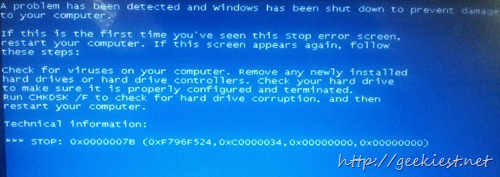
My friends laptop was displaying the above screen, which is showing the Technical Information as
0x0000007b (0xba4cb524, 0xc0000034, 0x00000000, 0x00000000)
After some time I found that in the BIOS, SATA HDD Settings was AHCI, and changing that to IDE solved the problem.
You can read a Microsoft Forum discussion regarding this here, EricTorbenson says
Is it possible that your laptop was installed with the BIOS set to Legacy mode, or from a disk image with the legacy IDE driver loaded as the storage controller?
PC manufacturers leave that legacy setting in the BIOS to make their SATA controllers emulate good old IDE controllers. This is very helpful when you want to install an older operating system from a time period when SATA did not exist, and no one writes SATA drivers for that OS. As an example, just try finding native-mode SATA drivers for Windows NT 4.0 or OS/2. The BIOS reports the disk controller's hardware ID to the system using the "new" AHCI hardware ID or an "old" generic IDE controller ID depending on the setting of the switch.
The STOP 7B error, as you guessed, refers to being unable to load a critical driver. Because of this, the OS cannot continue loading. At a bare minimum, XP's boot loader needs to be able to load the HAL (which is working) and the storage controller driver (which is not) to get the rest of the OS to boot. These two drivers aren't plug-and-play in the traditional sense when you're running XP; there's a hard-coded pointer to the disk controller's hardware ID. Your loaded driver is pointing to the legacy ID, which is only exposed to the OS when the AHCI switch is flipped to Legacy. When you switch it to AHCI, the BIOS reports a different ID, and the OS gives up because it can't find a match. Everything grinds to a halt because the system can't go any further without fully mounting the system disk.
You should be able to correct this by going to Dell's website and downloading the correct storage controller drivers. Replace the standard IDE disk controllers in Device Manager (Update Driver...) and reboot. Before the OS boots, go to the BIOS and switch the AHCI switch back on.
By the way, the reason it worked in Vista is because Windows 7 and Vista use a totally different boot manager that can dynamically detect storage controllers.